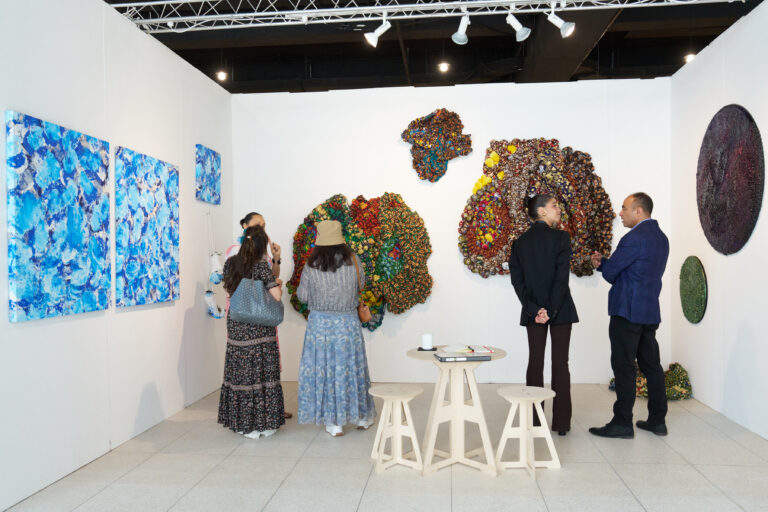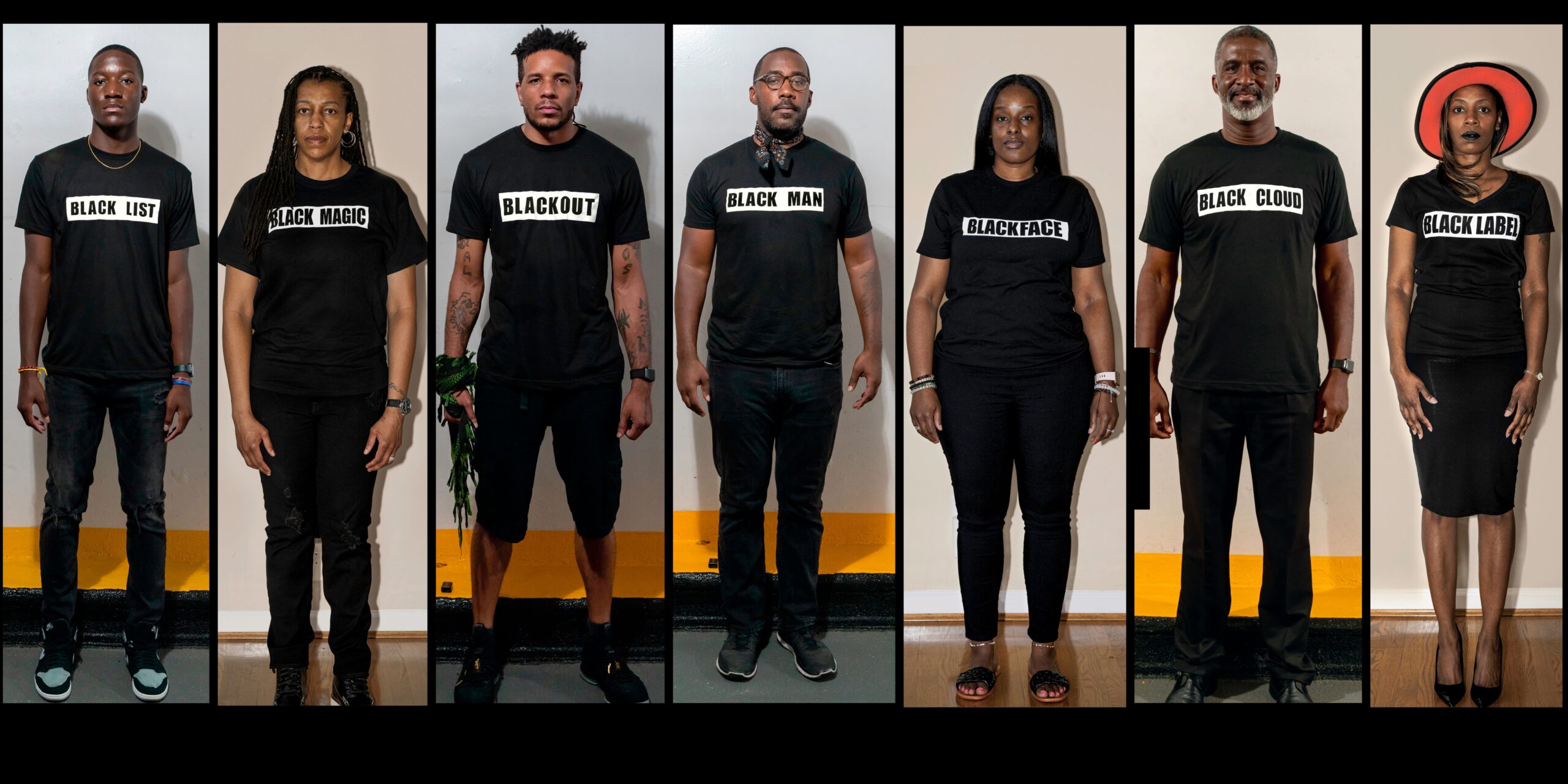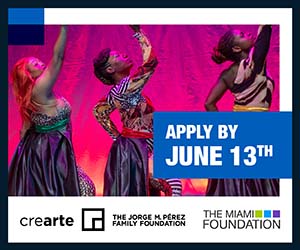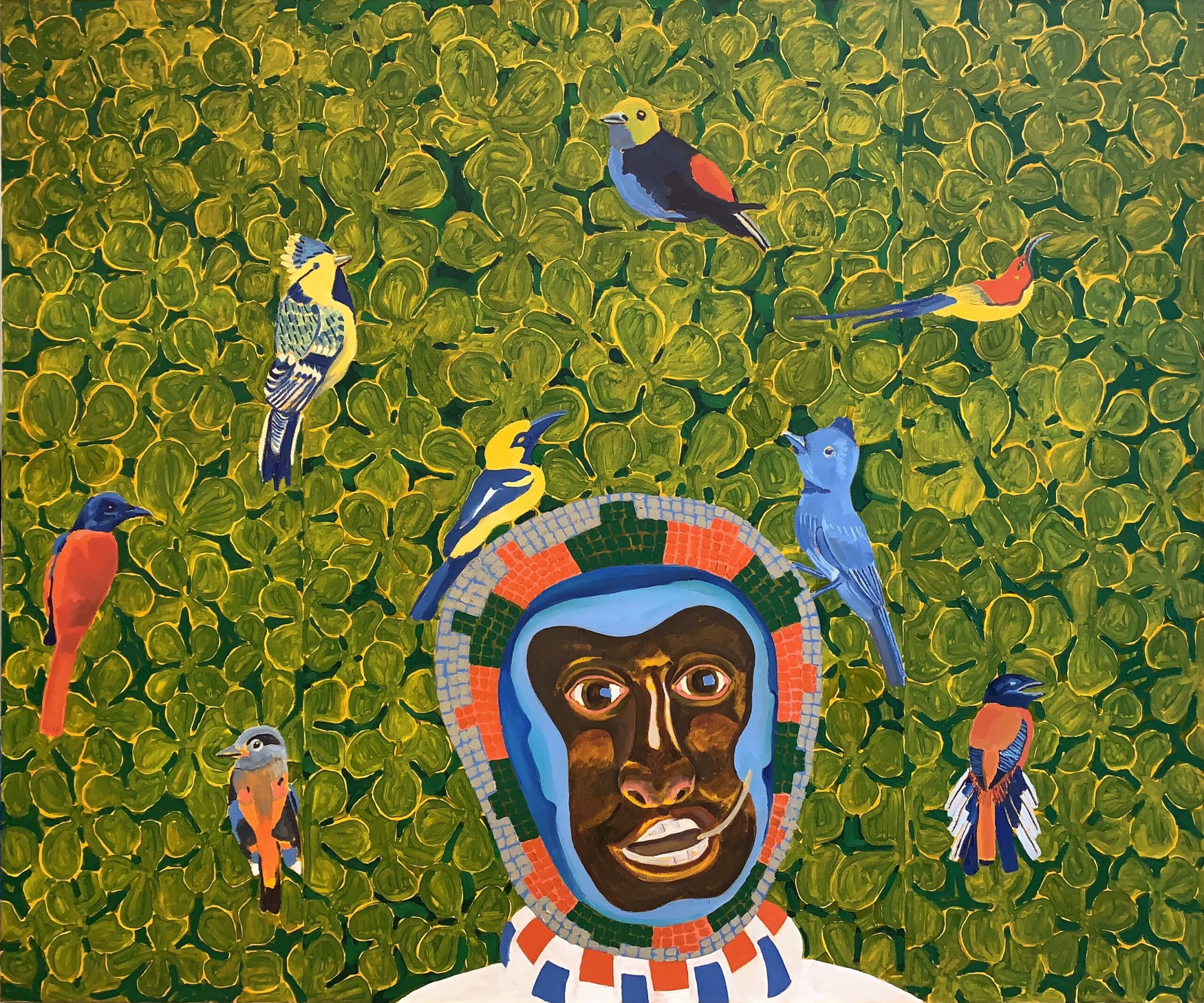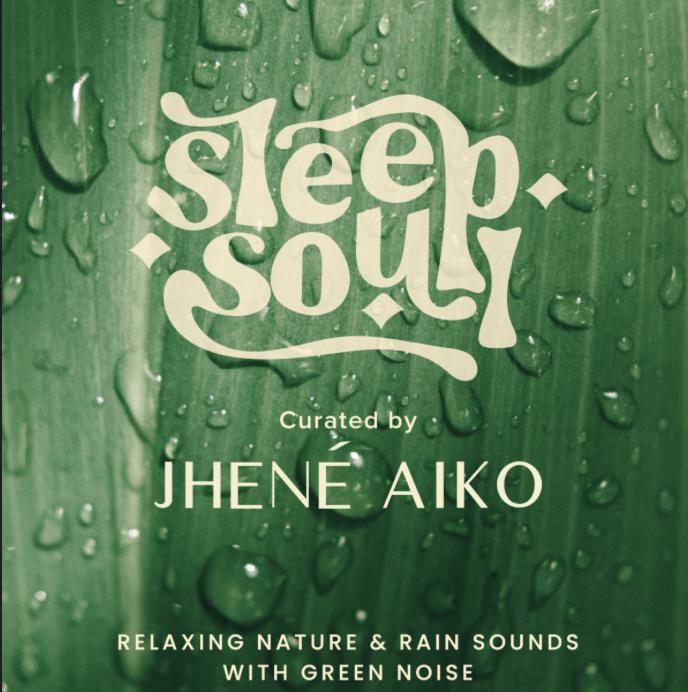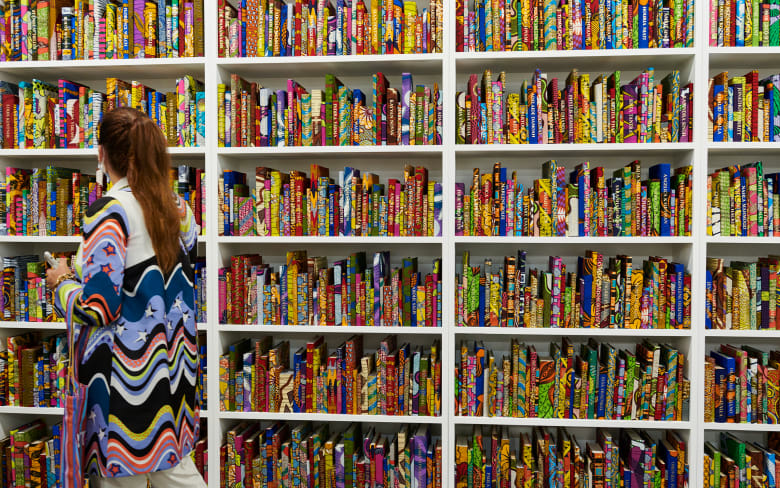Above: Black Box Men and Women | courtesy ArtCrawl Harlem
Black Eye. Black Sheep. Black Ball. Black Cloud. Conceptual artist Michael Coppage lends a new understanding of how the word “black,” simply a color, connotes negativity in his community project exhibit, Black Box (July 23-Aug. 21, 2022 at ArtCrawl Harlem, Governor’s Island, New York). Phrases beginning with “black” almost always have a dubious meaning, and this phrasing can cast Black people in a negative light. Coppage wears a “BLACK MAN” T-shirt to illustrate his point.
Black Box is a series of 26 six-foot-tall photographs of Black men and women staring straight at the camera in a police-lineup pose, with arms at their sides. Each wears a black T-shirt bearing the word “BLACK” (all upper case), followed by a noun that connotes outcasts (BLACK SHEEP), inclement weather (BLACK CLOUD), underprivileged (BLACK MOM), bad luck (BLACK CAT), evil (BLACK MAGIC) and 21 others. The exhibit began with 13 men and was first shown in Cincinnati, where Coppage resides. It is a community impact project that has appeared in the U.S. and Europe to positive reactions and acclaim. It has since expanded to include 13 women as well as LGBT subjects.
At an artist-talk during ArtCrawl Harlem’s exhibition opening on July 23, Coppage told arts and culture writer Jewels Dodson about his artistic origins, many aspects of his work, and Black Box. The Black Box represents a construct that American society expects Black people to conform to. Black success, he said, has fallen into three roles that society and culture assign: entertainer (comedian, actor, rapper, etc.), athlete (basketball, football), and criminal. Even young boys, he added, when asked what they would like to be when they grow up, want to be entertainers or athletes.
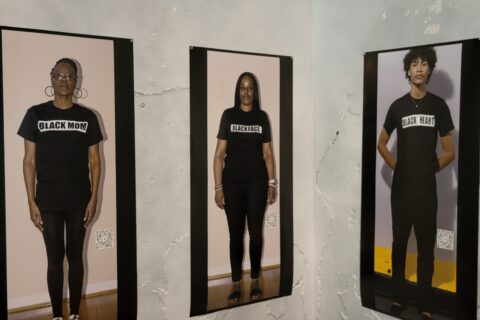
Above: Black Mom, Black Face, and Black Heart
When he was in the third grade, Coppage discovered he had a talent for drawing. But as a teenager, he experienced the Black Box in play. “When I got into high school, my father really pushed me to play high school football,” he said. “He was a high school football star, so he’s like, play football.” When Coppage declared art as his high school major, his father stopped speaking to him. The cold shoulder lasted until after he graduated from the Memphis College of Art and proved he could make a good living as a creative.
“No matter what your job title is, you bring creative solutions to that role, and so, there’s no such thing as a starving artist,” he said in an interview with this reporter. He went on to obtain a Master of Fine Arts degree from Pennsylvania Academy of the Fine Arts (PAFA) with an emphasis in sculpture and mixed media. Known before this work (and currently) as a painter and sculptor, he told me that himself standing at six feet tall, he prefers large-scale works, and has not created a painting or sculpture less than four feet.
The subjects range in age from 12 to 93. All were interviewed for a podcast, each photograph displaying a QR code that takes viewers to the interview. (A cellphone with a QR code scanner and a headset are recommended for this experience.) Customizable T-shirts offered to the public contain a QR code on the tag.
As a conceptual artist, Coppage both points out the problem and offers a solution. He said that our society and culture are ready to move forward as the widespread acceptance of respecting personal pronouns (he, she, they) has set things in motion. “I feel like the pronoun integration has been extremely rapid. It came out of nowhere in the last three to four years. It’s very much a thing, but this kind of change seems slower or harder. When our lives went primarily virtual for a couple of years, it accelerated that pronoun piece. Now, we are primed for this.
“Seeing ‘black cloud,’ we can say ‘storm cloud.’ ‘Blackmail,’ we could say ‘extortion.’ For ‘black sheep,’ it’s just an ‘outcast.’ Alternatives that we can identify and come up with that might help reduce the stigma. We collectively use these words so regularly and so routinely, we use them so casually, without understanding their impact. Culturally, if we become aware of the language, we can reduce and transform thought. There are some small steps that we can all take, even if that doesn’t look like action or protesting or politics. This is the way that everyone can contribute.”
In an unexpected twist, Coppage said that every subject photographed is the opposite of what their T-shirt implies, for example, “BLACK MOM.”
“Monique is ‘BLACK MOM.’ Monique has three kids from three different fathers,” Coppage said. “She’s a single mom but Monique is like a beast. She’s the vice president of a company. She makes really good money. She’s the face of her neighborhood. She’s got the most infectious energy, and when she embraces anyone, she almost gives you a chiropractic experience. When I think of Black mom, it’s not the stereotype that we associate with the Black mothers, but like the Black moms that I know and that I love and that I grew up with. She was the best representative.”
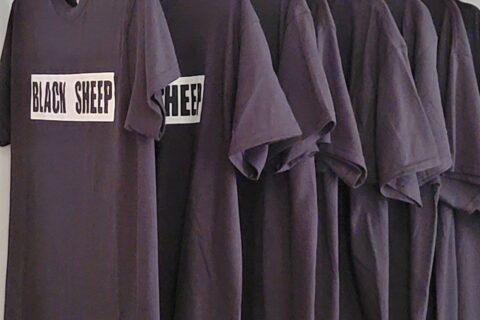
Above: Black Sheep T-Shirts
Bold black lettering on a white background appears prominently on the T-shirts. This reporter asked about the significance of this display. “I feel like we very much operate in white society,” Coppage said. “The environment that we have to navigate beyond our homes and our communities is predominantly white. So here we are as these Black characters—in the form of letters on the shirt—Black characters in this white space, and we have to navigate, find our meaning. So, the white box with the black letters is kind of a metaphorical depiction.”
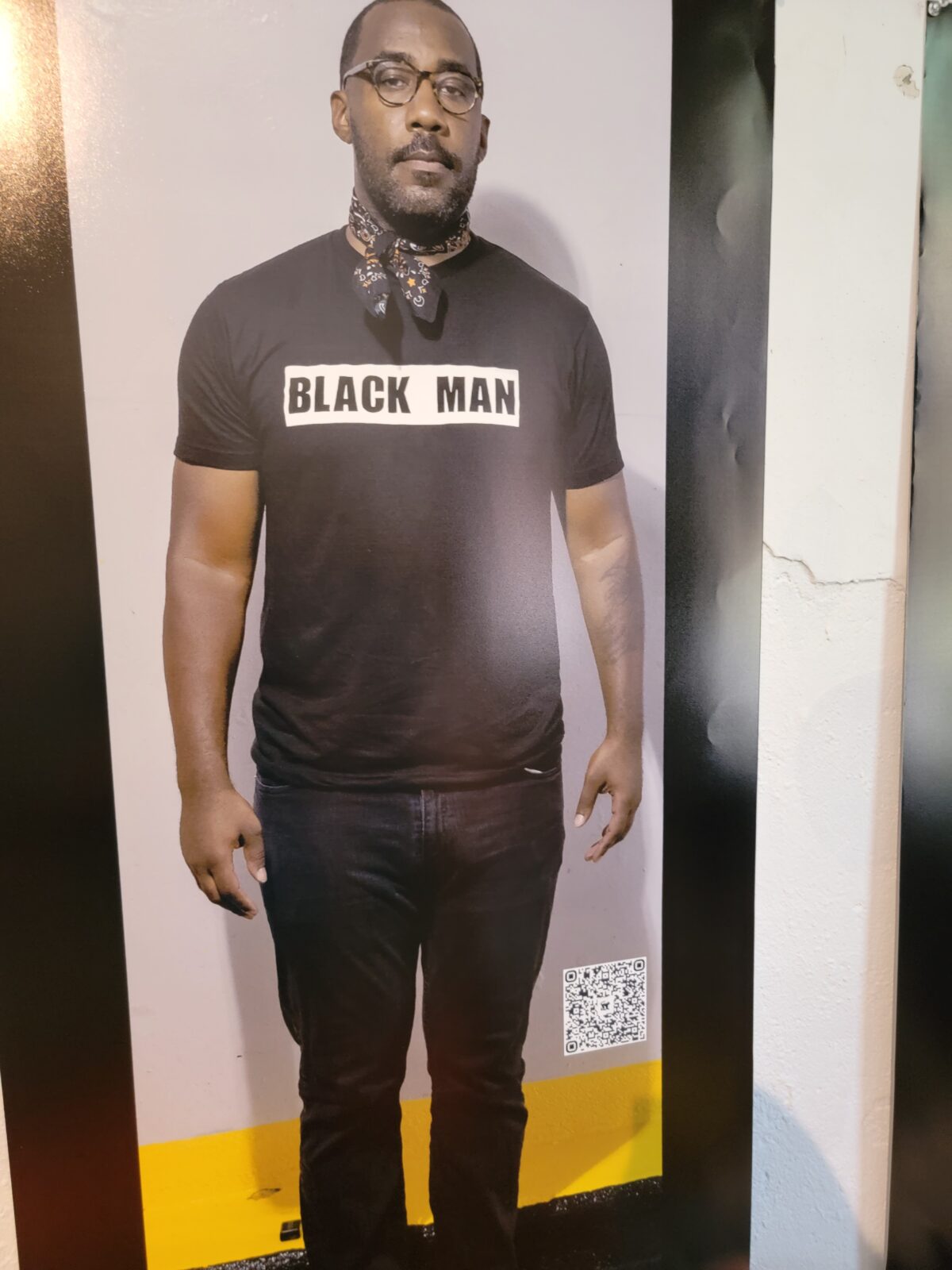
Above: Michael Coppage
For this project, Coppage is not in it to make money but to deliver the Black Box message. Coppage told this reporter, “At the 21c Museum (Cincinnati), they sell 20 shirts a week, and they have since last March (2021). I don’t make the money. There’s a woman, a Black-owned business, who makes the T-shirts. I introduced her to the museum gift shop. So, I used my project to leverage my relationship with the institution to bring in another Black creative and to share in the equity of what that connection could bring. I’m always trying to find out who else I can bring in, who can benefit from this opportunity besides myself. For me, I just need the platform.”
If you miss it at Governor’s Island, we suggest that the best time and place to experience Black Box will be at Coppage’s solo exhibition in collaboration with Photofocus during BLINK 2022 in Cincinnati (Oct. 13-16, 2022)—a multimedia exhibit at the Weston art gallery. The show is expected to be the largest lens-based art exhibition in the U.S. and, in Coppage’s words, “the most comprehensive exhibition of this project since its inception.”
The upper gallery will display museum-quality images of the 26 Black Box subjects. In the lower gallery, an actual Black Box that visitors can walk into will surround them on all four sides with a four-channel video of the subjects. Outside, on the facade of the gallery building, a 60-foot installation of one of the Black Box images will display. It will be project-mapped, a technique allowing overlapping video onto any surface. In addition, the outdoor portion will include a large, outdoor, animated, light-based show.
